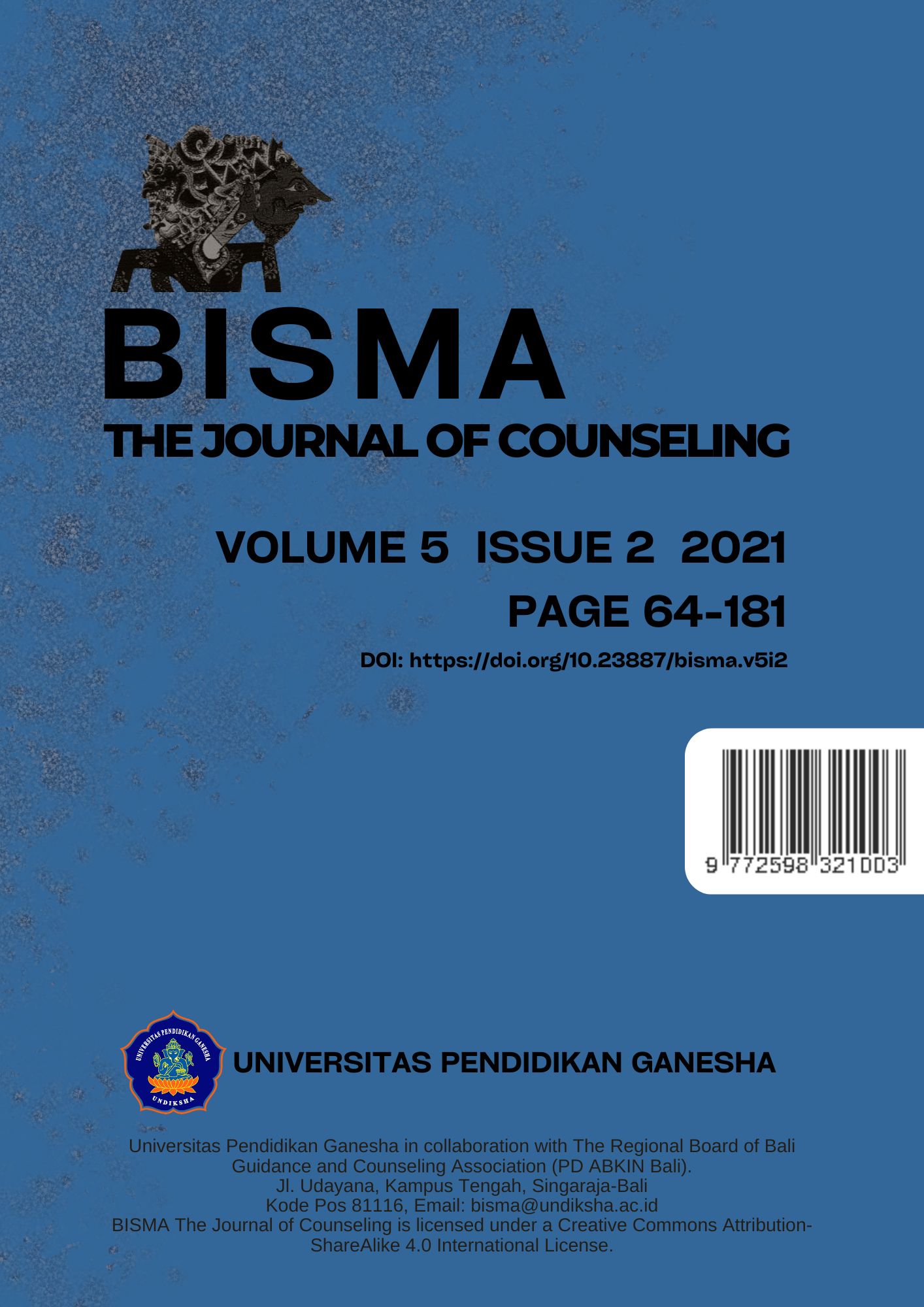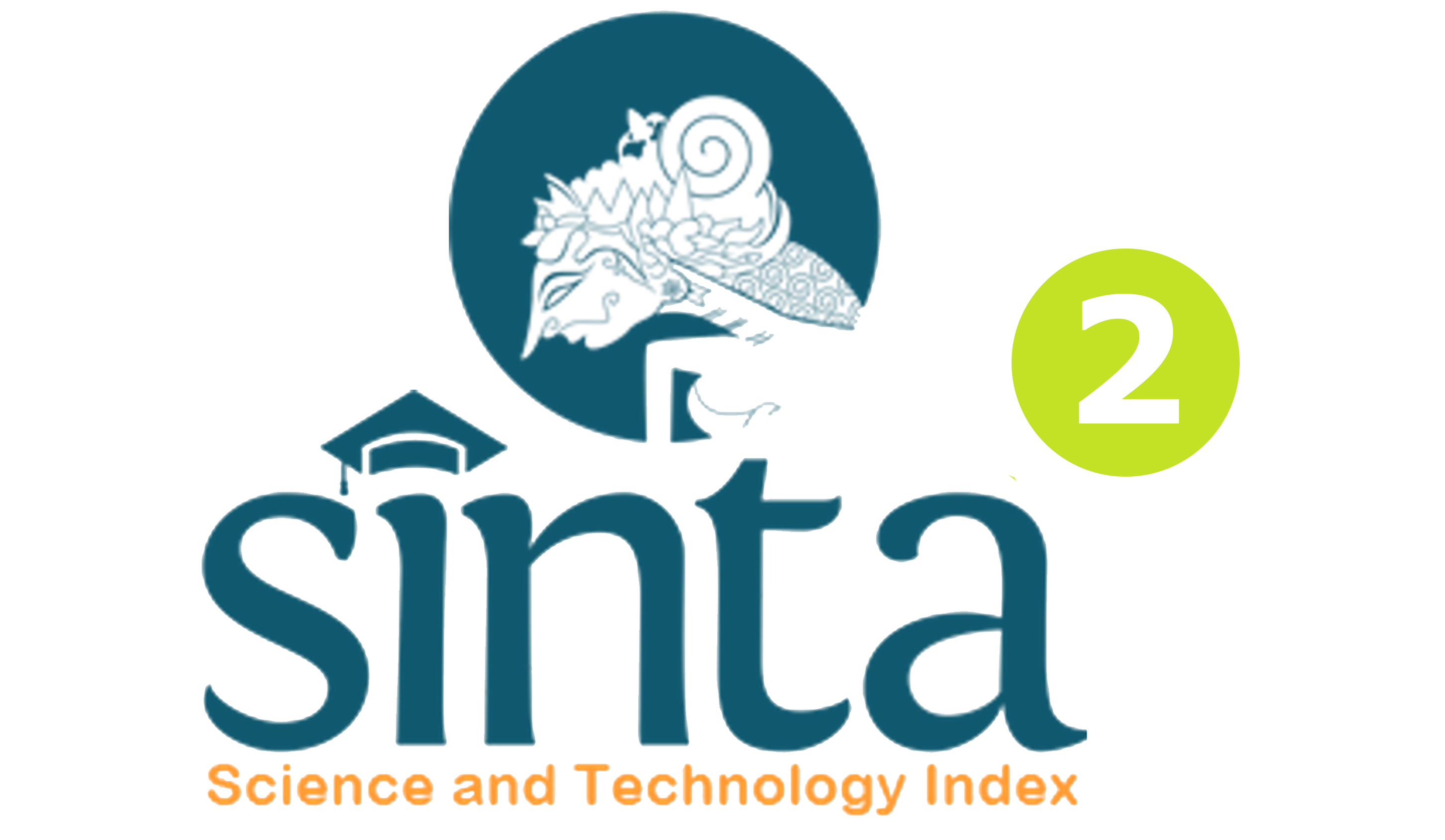Solution-focused Brief Counseling Guidebook to Reduce Student’s Academic Procrastination
DOI:
https://doi.org/10.23887/bisma.v5i2.37886Keywords:
Student’s academic procrastination, solution-focused brief counseling, counseling guidebookAbstract
This study aims to develop and evaluate solution-focused brief counseling guidebook as an instrument to reduce student’s academic procrastination. This research and development conducted by following 4D model by Thiagarajan that consist four stages of development namely (1) define, (2) design, (3) development, and (4) disseminate. Five experts are involved as judges to evaluate the content validity of counseling guidebook. The piloting study were conducted in one group pretest-posttest design to evaluate the effectivity of counseling guidebook to reduce student’s academic procrastination. Result of expert judgments were analyzed using formula Lawshe and show that the counseling guidebook has “very special” content validity index ( CVI = 1). Based on the results of piloting study, it was reported that counseling guidebook developed in this study effective in decrease student’s academic procrastination levels. The results of this study contribute to the development of guidance and counseling services.References
Ali Rachman, M. A. R. (2014). Efektifitas Konseling Singkat Berfokus Solusi (Solution Focused Brief Therapy) Untuk Meningkatkan Self Esteem Mahasiswa Program Studi Bimbingan Konseling Fkip Unlam Banjarmasin. 48, 62(4), 7.
Apóstolo JL, K. K. (2009). The effects of guided imagery on comfort, depression, anxiety, and stress of psychiatric inpatients with depressive disorders. Arch Psychiatr Nurs, 6(23), 403–411.
Arofah, L., Nawantara, R. D., & Puspitasari, A. D. (2018). Pengembangan Panduan Solution Focused Brief Counseling Untuk Guru Bk Sekolah Menengah Pertama Negeri (Smpn) 1 Kota Kediri. Bikotetik (Bimbingan Dan Konseling: Teori Dan Praktik), 2(1), 100. https://doi.org/10.26740/bikotetik.v2n1.p100- 104
Bakar, A. Y. A., & Suranata, K. (2020). Application of Solution-Focused Brief Therapy (SFBT) to Help Clients with Anxiety Issues. Bisma The Journal of Counseling, 4(1), 16-20.
Brannon, L., & Feist, J. (2000). Health psychology : an introduction to behavior and health. Matrix Production Inc.
Burka, J. ., & Yuen, L. . (2008). Procrastination: Why you do it, what to do about it. Da Capo Press. Carolia, F. (2012). Profil perilaku prokrastinasi akademik berbasis. 7(1), 19–20.
Chun Chu, A. H., & Choi, J. N. (2005). Rethinking procrastination: Positive effects of “active” procrastination behavior on attitudes and performance. Journal of Social Psychology, 145(3), 245–264. https://doi.org/10.3200/SOCP.145.3.245-264
Cohen, L., Manion, L., & Morrison, K. (2007). Research Methods in Education. In Professional Development in Education (Sixth, Vol. 38, Issue 3). Routledge. https://doi.org/10.1080/19415257.2011.643130
Corey, G. (2009). Theory and Practice of Counseling and Psychotherapy. Brooks/Cole.
De Shazer, S., Dolan, Y., Korman, H., Trepper, T., McCollum, E., & Berg, K. I. (2007). More Than Miracles: The State of the Art of Solution-Focused Brief Therapy. Taylor & Francis.
Erfatinni, I., Purwanto, E., & Japar, M. (2016). Konseling Kelompok Cognitive-Behavior Therapy Dengan Teknik Cognitive Restructuring Untuk Mereduksi Prokrastinasi Akademik. Jurnal Bimbingan Konseling, 5(2), 119–125.
Fernando, F., & Rahma, I. . (2016). Konsep Bimbingan dan Konseling Islam Solution Focused Brief Therapy (SFBT) untuk Membantu Menyembuhkan Perilaku Prokrastinasi Mahasiswa. Edukasi : Jurnal Bimbingan Konseling, 2(2), 215–236.
Ferrari, J. R, Johnson, J. ., & Mc Cown, W. G. (1995). Procrastination and Task Avoidance, Theory, Research and Treatment. Pelnum Press.
Ferrari, Joseph R., Johnson, J. L., & McCown, W. G. (1995). Procrastination and Task Avoidance.
Franklin, C., Moore, K., & Hopson, L. (2008). Effectiveness of solution-focused brief therapy in a school setting. Children & Schools, 30(1), 15-26.
Fibrianti, I. (2009). Procrastination and Task Avoidance, January 1995. https://doi.org/10.1007/978-1-4899-0227-6
Freeman, E. K., Cox-Fuenzalida, L. E., & Stoltenberg, I. (2011). Extraversion and Arousal Procrastination: Waiting for the Kicks. Current Psychology, 30(4), 375–382. https://doi.org/10.1007/s12144-011-9123-0
Gading, I. ketut. (2014). Pengaruh pelatihan kendali diri dan jenis kelamin terhadap perilaku prokrastinasi akademik siswa SMP. Universitas Negeri Malang.
Gafni, R., & Geri, N. (2010). Time management: Procrastination tendency in individual and collaborative tasks. Interdisciplinary Journal of Information, Knowledge, and Management, 5, 115–125. https://doi.org/10.28945/1127
Gay, LR, G. E. M. and P. A. (2009). Educational Research, Competencies for Analysis and Application. Pearson Education, Inc.
Genders, N. (2006). Fundamental aspects of complementary therapies for health care professionals. Chapter 7: CAM therapies in practice: art therapy, music therapy and relaxation and imagery. Quay Books Mark Allen Group, 85–98.
Ghufron, M., & Rini, F. (2014). Teori-teori Psikologi. AR-Ruzz Media.
Grocke, D., & Moe, T. (2015). Guided Imagery & Music ( GIM ) and Music Imagery Methods for Individual. May, 2015.
Guterman, J. T. (2015). Mastering the Art of Solution-Focused Counseling: Second Edition (Second). American Counseling Association. https://doi.org/10.1002/9781119221562
Hall, E., Hall, C., Stradling, & Young, D. (2006). Guided imagery Creative Interventions in Counseling & Psychotherapy. SAGE Publication.
Hanton, P. (2011). Skills in solution focused brief: Counselling & psychotherapy. In Skills in Solution Focused Brief: Counselling and Psychotherapy. https://doi.org/10.4135/9781446251980
Hart, J. (2008). Guided Imagery. Mary Ann Liebert, INC.
Höcker, A., Engberding, M., Beißner, J., & Rist, F. (2008). Evaluation einer kognitiv- verhaltenstherapeutischen intervention zur reduktion von prokrastination. Verhaltenstherapie, 18(4), 223–229. https://doi.org/10.1159/000167857
Hudaya, R. (2011). T Ime D Elay E Stimation a Lgorithms for E Cho. 9(1), 21–28.
Humphrey, P., & Harbin, J. (2010). An Exploratory Study of the Effect of Rewards and Deadlines on Academic Procrastination in Web-Based Classes. Academy of Educational Leadership Journal, 14(4), 91.
Ilfiandra. (2015). Program Bimbingan Karir Untuk Meningkatkan Kematangan Karir Siswa Sekolah Menengah Kejuruan Studi Deskriptif Terhadap Siswa Kelas XI SMK Nasional Depok Tahun Ajaran 2009/2010. 2504, 1– 9.
JacobsonA.F. (2006). Cognitive‐Behavioral Interventions for IV Insertion Pain. AORN Journal, 84, 1031– 1048.
Kaplan, H. I., & Sadock, B. . (2010). Retardasi Mental dalam Sinopsis Psikiatri. Binarupa Aksara.
Kelly, M. S., Kelly, M. S., Kim, J. S., & Franklin, C. (2008). Solution focused brief therapy in schools: A 360 degree view of research and practice. Oxford University Press.
Knaus, W. J. (2002). The Procrastination Workbook: Your Personalized Program for Breaking Free From The Patterns That Hold You Back. New Harbinger Publications.
Kurnanto, M. E. (2019). Solution Focused Brief Counseling (SFBC): Study in Students with Academic Procrastination. GUIDENA: Jurnal Ilmu Pendidikan, Psikologi, Bimbingan Dan Konseling, 9(1), 7. https://doi.org/10.24127/gdn.v9i1.1579
Kusumawide, K. T., Nanda, W., Saputra, E., & Alhadi, S. (2019). Keefektifan Solution Focused Brief Counseling (SFBC) untuk menurunkan perilaku prokrastinasi akademik Siswa. 9(2), 89–102. https://doi.org/10.25273/counsellia.v9i2.4618
Lagana-Riordan, C., Aguilar, J. P., Franklin, C., Streeter, C. L., Kim, J. S., Tripodi, S. J., & Hopson, L. M. (2011). At-risk students’ perceptions of traditional schools and a solution-focused public alternative school. Preventing School Failure, 55(3), 105-114.
Lawshe, C. H. (1975). a Quantitative Approach To Content Validity. Personnel Psychology, 28(4), 563–575. https://doi.org/10.1111/j.1744-6570.1975.tb01393.x
Lukas, C. A., & Berking, M. (2018). Reducing procrastination using a smartphone-based treatment program: A randomized controlled pilot study. Internet Interventions, 12, 83–90. https://doi.org/10.1016/j.invent.2017.07.002
Mangen, A., & Kuiken, D. (2014). Lost in an iPad. Scientific Study of Literature, 4(2), 150–177. https://doi.org/10.1075/ssol.4.2.02man
Milgram, N. A., Batori, G., & Mowrer, D. (1993). Correlates of academic procrastination. Journal of School Psychology, 31(4), 487–500. https://doi.org/10.1016/0022-4405(93)90033-F
Newsome, W. S. (2005). The impact of solution-focused brief therapy with at-risk junior high school students. Children & Schools, 27(2), 83-90.
Suranata, K., & Prakoso, B. B. (2020). Program web-based SFBC untuk mereduksi kecemasan akademik siswa saat pandemi COVID-19; sebuah pilot studi. JPPI (Jurnal Penelitian Pendidikan Indonesia), 6(2), 47-52.
Swandevi, N. K. A., Suranata, K., & Dharsana, I. K. (2020). Development of The Solution Focused Brief Counseling (SFBC) to Improve The Autonomy of Vocational School Students. Bisma The Journal of Counseling, 4(2), 98-107.









